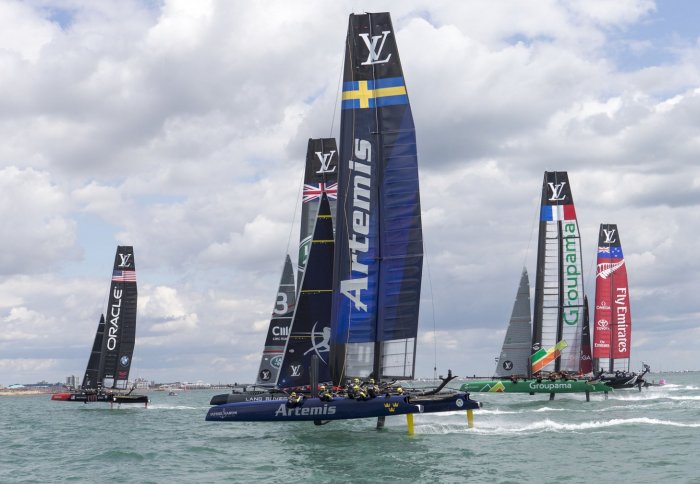

Imperial researchers have won an Academy of Management award for a study that reveals how imitation can help businesses stay ahead of their rivals.
Dr Dmitry Sharapov, Assistant Professor, Department of Innovation and Entrepreneurship and Dr Jan-Michael Ross, Assistant Professor, Department of Management, both from the Business School, won the Distinguished Paper Award at the annual Academy of Management Meeting in Vancouver, for a study that uses data from the America’s Cup to explore when imitation strategies can help business leaders stay ahead of multiple competitors.
The researchers used data from fleet sailing races of the America’s Cup World Series 2011-2013 to show how managers can make better business decisions in challenging environments.
To mark the next stage of the 2015 America’s World Cup World Series, which opens today in Gothenburg, Sweden, you can watch a video of the researchers discussing their previous work on how imitating companies can benefit businesses in head-to-head competitions. This study also uses data from the America’s Cup and is featured in the Academy of Management Journal.
You can read a Q&A interview with the researchers below.
Broadly speaking, what can businesses learn from the America’s Cup?
DS: Like many other sports, the America’s Cup provides various learning opportunities. The parallels between business and sport are strong: both involve selecting the right people to form teams, and getting them to develop their leadership and motivational skills, and learning how to allocate resources effectively.
Just like business, the captain and crew need to make good strategic and tactical decisions while rivals are trying to get ahead of them. The America’s Cup is particularly interesting because the participating teams are faced with a competition that involves both sport and technological development.
This means that crews have to both improve the design of their yacht, and then launch it and compete in the race. In a similar way, businesses develop or acquire technologies, design their products, and launch them on to the market in the hope that their products are better selling than their competitors.
JMR: Generally, businesses can learn from these crews how to effectively cope with the various challenges they face. For example, consider the learning journey of Team Oracle, the American team who won the 34th America’s cup in 2013. They were eight races behind the challenger, Team New Zealand, and they came from behind to win the Cup by nine races to eight. What a comeback! Leadership, team selection, use of technologies, and decision-making skills in highly dynamic environments were very effectively implemented to achieve their win.
What can businesses learn from competitive interactions in sailing competitions?
DS: The decisions that these teams are making are similar to those facing businesses. What makes the analogy of sailing so fascinating is that these teams, similar to businesses developing and launching products, have to make decisions under different types of uncertainty.
Some of the uncertainties in the design of a yacht can be lowered by repeating tests in computer labs or through experimentation with prototypes. Others are independent of any actions taken by the teams, such as the uncertainty that arises from the unpredictability of wind conditions in sailing or uncertainty about the customer preferences in businesses.
JMR: Similar to the America’s Cup teams, businesses are forced to make short-term and long-term decisions under exactly those challenging conditions.
Market environments can be highly uncertain. You never know what the next move of the competitor is going to be. Businesses have to make decisions considering the moves of the competitor and their own abilities to use given technologies. There is often no time for waiting until uncertainties are resolved.
The strategic and tactical moves the leader of a sailing race chooses to avoid losing can provide valuable insights for companies about how we think and teach about the intense battle for market leadership taking place in different industries.
Tell me more about your recent research around this topic?
DS: In the recently published Academy of Management article, we have been looking at the effectiveness of a “follow the follower” imitation strategy, in which the leading boat imitates the moves and positioning of the follower in order to stay ahead, under different environmental and competitive conditions.
To do this, we analysed data from head-to-head races in the 2011-2012 America’s Cup World Series which is the competition where the teams vie to be the ‘challenger’ to compete in the America’s Cup against the defending team.
JMR: We believe that this work has relevance for a broader management audience. The theoretical insights from this study help to explain, for example, why Apple decided to imitate Samsung’s decision to release phones with larger screens.
Since imitation strategies often have the negative image of being a ‘copycat’, we hope that the insights from the study and the analogy to sailing competitions in general provide managers with new arguments to illustrate the benefits of imitation strategies in board-room discussions.
DS: Our new paper, which received the award at the Academy of Management conference, extends this line of work by considering whether imitation strategies can also be effective for a leader when competing against multiple rivals.
In such situations the leader can choose which rival to imitate, and we find that the effectiveness of imitation strategies targeting alternative rivals depends on the types of changes affecting the competitive environment.
JMR: In this work-in-progress and in future research we aim to explore in detail when and how imitation strategies can help leaders to stay ahead, and to provide evidence from different competitive contexts that can be used by business leaders in various industries.
America's Cup image credit: 34th America's Cup Photo Library
Article text (excluding photos or graphics) available under an Attribution-NonCommercial-ShareAlike Creative Commons license.
Photos and graphics subject to third party copyright used with permission or © Imperial College London.
Reporter
Laura Singleton
Communications Division




